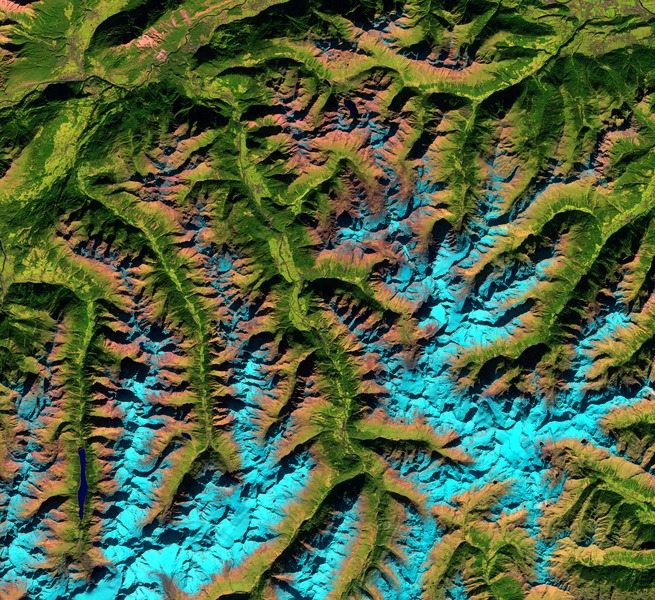File:Ötztal Alps ESA373262.tiff

Original file (2,554 × 2,338 pixels, file size: 34.2 MB, MIME type: image/tiff)
Captions
Captions
Summary[edit]
| DescriptionÖtztal Alps ESA373262.tiff |
English: The Copernicus Sentinel-2A satellite takes us over the Ötztal Alps in the western Austrian state of Tyrol in this image from 16 October 2016.
The shadows across the image may play tricks on the eye, making the valleys – the green areas – look like they stand higher than the light blue mountains. Sometimes rotating the image so the shadows fall in a different direction can ‘fix’ this optical illusion. Snow appears in shades of blue in this unusual false-colour image using light in the near- and shortwave infrared part of the spectrum. This colouring makes it easier to distinguish between snow and vegetation. It also allows us to differentiate between clouds and snow, which is difficult in other parts of the spectrum as they are usually both white. But there are no clouds visible in this image to demonstrate the effect. In the upper left we can see part of the Inn River, flowing east from the Swiss Alps and through Austria and Germany before entering the Danube (not pictured). The land in the Inn river valley and other river valleys appear green with patches of agriculture. The highest peak in the Ötztal range is Wildspitze, standing over 3770 m. The mountain is visible in the lower-left corner, east of the elongated lake, Gepatschspeicher. The well-preserved natural mummy of a man from about 5300 years ago was found just 12 km south of Wildspitze (not pictured). The body was discovered by two tourists in 1991, and named ‘Ötzi’ after the Ötztal Alps. While the discovery of the mummy allowed for new insights into the Chalcolithic period, it also revealed new information on changes in climate over the past millennia. Together with other evidence, the burial of the corpse by snow and ice indicates a rapid climactic cooling soon after his death, preserving the body for over 5000 years before glacial melt from rising temperatures exposed the mummy. This image is featured on the Earth from Space video programme. |
| Date | |
| Source | http://www.esa.int/spaceinimages/Images/2017/02/Oetztal_Alps |
| Author | European Space Agency |
| Permission (Reusing this file) |
contains modified Copernicus Sentinel data (2016), processed by ESA ,CC BY-SA 3.0 IGO |
| Other versions |
|
| Title InfoField | Ötztal Alps |
| Set InfoField | Earth observation image of the week |
| System InfoField | Copernicus |
| Mission InfoField | Sentinel-2 |
| Location InfoField | Alps |
| Activity InfoField | Observing the Earth |
| Keywords InfoField | Satellite image; Mountain |
Licensing[edit]
- You are free:
- to share – to copy, distribute and transmit the work
- to remix – to adapt the work
- Under the following conditions:
- attribution – You must give appropriate credit, provide a link to the license, and indicate if changes were made. You may do so in any reasonable manner, but not in any way that suggests the licensor endorses you or your use.
- share alike – If you remix, transform, or build upon the material, you must distribute your contributions under the same or compatible license as the original.

File history
Click on a date/time to view the file as it appeared at that time.
| Date/Time | Thumbnail | Dimensions | User | Comment | |
|---|---|---|---|---|---|
| current | 14:55, 6 May 2017 |  | 2,554 × 2,338 (34.2 MB) | Fæ (talk | contribs) | == {{int:filedesc}} == {{information | description = {{en|1=The Copernicus Sentinel-2A satellite takes us over the Ötztal Alps in the western Austrian state of Tyrol in this image from 16 October 2016. The shadows across the image may play tricks on t... |
You cannot overwrite this file.
File usage on Commons
The following page uses this file:
Metadata
This file contains additional information such as Exif metadata which may have been added by the digital camera, scanner, or software program used to create or digitize it. If the file has been modified from its original state, some details such as the timestamp may not fully reflect those of the original file. The timestamp is only as accurate as the clock in the camera, and it may be completely wrong.
| Width | 2,554 px |
|---|---|
| Height | 2,338 px |
| Bits per component |
|
| Compression scheme | Uncompressed |
| Pixel composition | RGB |
| Image data location | 32,144 |
| Orientation | Normal |
| Number of components | 3 |
| Number of rows per strip | 2,338 |
| Bytes per compressed strip | 35,827,512 |
| Horizontal resolution | 72 dpi |
| Vertical resolution | 72 dpi |
| Data arrangement | chunky format |
| Software used | Adobe Photoshop CC 2017 (Windows) |
| File change date and time | 11:50, 21 November 2016 |
| Color space | Uncalibrated |
